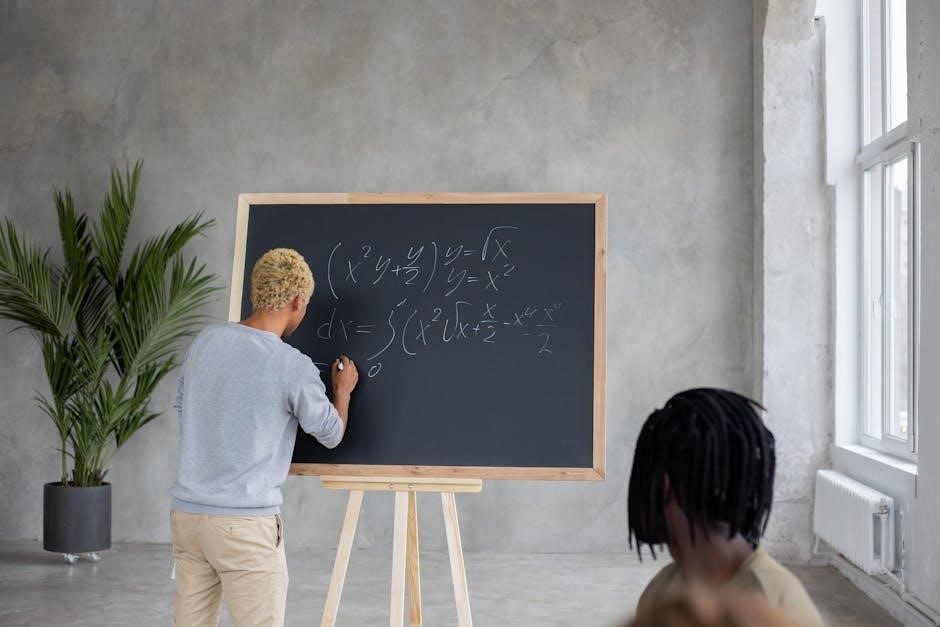Systems of linear equations are fundamental in math education, enabling the modeling of real-world scenarios through word problems. These problems span economics, physics, and engineering, fostering practical problem-solving skills.
What Are Systems of Linear Equations?
A system of linear equations consists of two or more equations with the same variables, where each equation represents a straight line in a graph. These equations are solved simultaneously to find the values of the variables that satisfy all equations. For example, a system might include equations like (2x + 3y = 7) and (x — 2y = -3). Systems can be solved using methods such as substitution, elimination, or matrix operations. They are widely used to model real-world problems, such as budgeting, mixture ratios, and physics applications. Word problems often require translating sentences into mathematical expressions, making systems of equations a practical tool for problem-solving across various disciplines. Understanding these systems is essential for developing analytical skills in mathematics and its applications.
Importance of Word Problems in Math Education
Word problems are essential in math education as they bridge the gap between abstract mathematical concepts and real-world applications. They help students develop problem-solving skills by translating written scenarios into mathematical expressions. Word problems encourage critical thinking, as they often require identifying relevant information and ignoring distractions. These problems also enhance communication skills, teaching students to articulate their reasoning and solutions clearly. By applying mathematical principles to practical situations, word problems make learning more engaging and relatable. They prepare students to tackle real-life challenges, such as budgeting, engineering, and economics, where mathematical modeling is crucial. Regular practice with word problems builds confidence and fluency in applying math to solve everyday problems effectively. Thus, they are a cornerstone of a well-rounded math education, fostering both analytical and practical skills.

Common Types of Word Problems
Word problems often involve mixtures, cost and pricing, and age-related scenarios. These problems require defining variables and setting up equations to solve real-world mathematical challenges effectively;
Mixture Problems
Mixture problems involve combining different substances or solutions to achieve a specific concentration or blend. These problems can be solved using systems of linear equations by defining variables for the quantities of each component. For example, if a recipe requires a mixture of cranberry and another juice, setting up equations based on the total volume and concentration allows for determining the exact amounts needed. Such problems are common in real-world applications, such as chemistry and cooking, and help develop critical thinking and algebraic skills. By translating the problem into a system of equations, students can systematically find the solution, ensuring accuracy and understanding of the underlying principles. These problems also illustrate how mathematics applies to everyday situations, making learning more engaging and practical.
Cost and Pricing Problems
Cost and pricing problems involve determining the total cost or price of goods and services based on given conditions. These problems often require setting up systems of linear equations to model the relationships between variables such as base fees, additional charges, and quantities. For instance, a delivery service might charge a fixed fee plus a cost per package, leading to equations that calculate total cost based on the number of packages delivered. Similarly, scenarios involving discounts or bundled pricing can be solved by defining variables and creating equations to represent the total cost or revenue. These types of problems are essential in economics and finance, teaching students how to budget, price products, and make informed financial decisions. By practicing these problems, students gain practical skills in applying algebra to real-world financial situations.
Age-Related Problems
Age-related problems involve determining the ages of individuals based on given conditions, often requiring the use of systems of linear equations. These problems typically involve defining variables for the current or past ages of people and setting up equations based on the relationships provided. For example, if a parent is three times as old as their child, or if the sum of two siblings’ ages is a specific number, systems of equations can be used to find their exact ages. These problems are common in math education because they teach students how to translate words into mathematical expressions and solve for unknowns. They also encourage critical thinking and the ability to interpret real-world scenarios. By practicing age-related problems, students improve their algebraic reasoning and problem-solving skills, essential for advanced mathematics.

Real-World Applications
Systems of linear equations are essential in economics, physics, and engineering for modeling real-world scenarios. They solve problems like resource allocation, pricing, and optimization, making them vital tools.
Economics and Finance
In economics and finance, systems of linear equations are crucial for analyzing market trends, pricing, and resource allocation. They help model supply and demand dynamics, optimize profit margins, and solve budgetary constraints. For instance, businesses use these systems to determine the optimal mix of products to maximize revenue or to set prices based on production costs and market conditions. Financial planners also rely on them to create investment strategies and manage risk. By breaking down complex financial scenarios into manageable equations, professionals can make informed decisions. These applications highlight the practical importance of linear systems in real-world economic and financial problem-solving.
Physics and Engineering
In physics and engineering, systems of linear equations are essential for solving problems involving forces, motion, and energy. They are used to model complex systems, such as electrical circuits or mechanical structures, where multiple variables interact. For example, in circuit analysis, linear equations help determine voltages and currents at different points. In mechanics, they can describe the equilibrium of forces acting on an object. Engineers also use these systems to optimize designs, ensuring safety and efficiency. By translating physical phenomena into mathematical equations, professionals can predict behavior, identify patterns, and develop innovative solutions. This application underscores the critical role of linear systems in advancing technological and scientific advancements.
Engineering Applications
Systems of linear equations play a crucial role in engineering, where they are used to model and solve complex problems. In structural engineering, these systems help analyze the distribution of forces and stresses in buildings and bridges, ensuring stability and safety. Similarly, in thermal engineering, they are applied to calculate heat transfer rates and temperature distributions. Linear systems are also integral in signal processing and control systems, enabling precise adjustments and optimizations. For instance, in designing electronic circuits, engineers use these systems to determine voltage and current flows. Real-world problems, such as optimizing material usage or predicting system behavior under varying conditions, rely heavily on linear equations. By leveraging these mathematical tools, engineers can make informed decisions, enhance performance, and drive innovation across diverse fields; Their applications are vast, making them indispensable in modern engineering practices.

Solving Systems of Linear Equations
Solving systems of linear equations involves methods like substitution and elimination, essential for addressing real-world word problems. These techniques provide clear, structured approaches to finding variable solutions efficiently.
Substitution Method
The substitution method is a straightforward technique for solving systems of linear equations. It involves solving one equation for a variable and substituting this expression into the other equation. This step-by-step approach ensures clarity and reduces complexity. First, identify an equation that can be easily solved for one variable. Once isolated, substitute this value into the second equation to find the remaining variable. For example, in the system:
y = 2x + 3
3x + y = 10
Solve the first equation for y and substitute into the second equation:
3x + (2x + 3) = 10
Simplify and solve for x, then back-substitute to find y. This method is particularly effective when one equation is already solved for a variable or can be easily manipulated to isolate it. It provides a systematic way to unravel interconnected equations, making it a reliable tool for solving word problems involving two or more variables.
Elimination Method
The elimination method is another powerful technique for solving systems of linear equations. It involves manipulating the equations to eliminate one variable, allowing the other variable to be solved first. This is often achieved by making the coefficients of a variable in both equations equal (or opposites) through multiplication. Once aligned, the equations are added or subtracted to eliminate the variable. For example, consider the system:
3x + 4y = 20
2x + 3y = 15
To eliminate x, multiply the first equation by 2 and the second by 3:
6x + 8y = 40
6x + 9y = 45
Subtract the first new equation from the second:
y = 5
Substitute y = 5 back into one original equation to find x. This method is efficient when the coefficients are suitable for elimination, providing a clear pathway to the solution. It is widely used in various applications, including word problems involving multiple variables.

Setting Up Equations from Word Problems
Setting up equations from word problems involves defining variables, translating words into mathematical expressions, and forming equations that logically represent the problem’s scenario. Clear definitions and accurate translations are essential for ensuring the equations mirror the real-world situation described.
Defining Variables
Defining variables is the first step in setting up equations from word problems. Variables represent unknown quantities, such as the number of packages or the cost per item. Choose meaningful letters or symbols to denote these quantities, ensuring clarity. For example, let x represent the number of adults and y represent the number of children attending an event. Clear variable definitions help translate words into mathematical expressions accurately. This process ensures that the equations formed logically represent the problem’s scenario. Always label variables with units, like dollars or hours, to maintain consistency and avoid confusion. Properly defined variables form the foundation for creating valid equations that can be solved systematically. This step is crucial for modeling real-world problems effectively.

Translating Words into Mathematical Expressions
Translating words into mathematical expressions is a critical skill in solving word problems. It involves converting descriptive language into algebraic equations. Keywords like “twice as many” or “total” indicate relationships between variables. For example, “the total cost is $25” translates to an equation like 5x + 2y = 25. Phrases such as “more than” or “less than” suggest addition or subtraction. Identifying these patterns helps in forming accurate expressions. Use variables defined earlier to represent unknowns. Practice is essential to master this translation, as it bridges the gap between language and mathematics. Proper translation ensures that the resulting equations accurately reflect the problem’s conditions, enabling effective solving. This step is vital for transforming verbal descriptions into solvable mathematical models. Consistent practice enhances proficiency in interpreting and converting word problems into equations.

Practice Problems and Worksheets
Practice problems and worksheets are essential for mastering systems of linear equations. They provide hands-on experience with real-world scenarios, reinforcing problem-solving skills and mathematical understanding. Regular practice improves accuracy and speed.
Where to Find Worksheets
Worksheets for systems of linear equations word problems are widely available online. Websites like MathWorks, Khan Academy, and Google Classroom offer free downloadable resources. Educational platforms such as Teachoo and Math Open Reference provide comprehensive collections. Additionally, online marketplaces like Teachers Pay Teachers feature curated worksheet bundles. Many school websites and forums also share these materials, catering to diverse learning needs. These resources are designed to help students practice and grasp the concepts effectively, offering a variety of problem sets tailored to different skill levels. Regularly practicing with these worksheets enhances problem-solving abilities and builds confidence in tackling real-world applications.
Benefits of Practicing with Worksheets
Practicing with worksheets on systems of linear equations word problems offers numerous benefits. They provide structured practice, helping students master defining variables, setting up equations, and solving systems. Worksheets expose learners to a variety of scenarios, enhancing problem-solving skills and critical thinking. Regular practice improves understanding of real-world applications, making abstract concepts more tangible. Additionally, worksheets allow students to apply different methods, such as substitution and elimination, reinforcing their knowledge. They also help identify common mistakes, enabling learners to refine their techniques. Over time, consistent practice builds confidence and fluency in tackling complex problems. Worksheets are invaluable for self-assessment and exam preparation, ensuring students are well-equipped to handle various challenges in mathematics;
To excel in solving word problems, focus on reading comprehension and identifying key details. Define variables clearly and translate words into mathematical expressions accurately. Always check your solutions to ensure they make sense in the context of the problem. Reading comprehension is crucial for solving word problems effectively. It involves carefully understanding the scenario, identifying key pieces of information, and translating them into mathematical expressions. Start by reading the problem multiple times to grasp the context and requirements. Pay attention to specific details like quantities, relationships, and constraints. Highlight or underline important phrases to help you focus. Asking yourself questions about what is given and what needs to be found can clarify the problem. Breaking down complex sentences into simpler parts ensures that you capture all necessary information. Avoid rushing through this step, as misinterpreting even a single detail can lead to incorrect equations and solutions. Checking solutions is an essential step in solving systems of linear equations, especially in word problems. After finding the values of the variables, it is crucial to verify that they satisfy the original equations and make sense in the context of the problem. Start by substituting the solutions back into the equations to ensure both sides are equal. Additionally, assess whether the answers are reasonable given the scenario. For example, if a problem involves quantities like time or money, the solutions should be positive and realistic. Graphical methods can also be used to confirm that the solution lies at the intersection of the two equations. Finally, always review your calculations to catch any arithmetic or algebraic errors. This step ensures accuracy and builds confidence in the final answer. Advanced topics explore complex systems beyond basic linear equations, introducing non-linear dynamics and multi-variable equations with applications in advanced fields. Non-linear systems involve equations where variables are raised to powers other than one or multiplied together, creating complex relationships. These systems often arise in real-world scenarios such as population growth, economics, and physics. Unlike linear systems, non-linear systems can have multiple solutions or no solutions, requiring advanced methods like graphical analysis or numerical techniques. Word problems involving non-linear systems challenge students to think critically and apply various problem-solving strategies. They also highlight the importance of understanding the underlying principles to interpret results accurately. Non-linear systems prepare students for higher-level mathematics and real-world applications where linear models are insufficient. Systems of linear equations with more than two variables introduce complexity, requiring additional equations to solve for each variable. These systems are common in real-world applications like engineering, economics, and physics, where multiple factors interact. Word problems involving three or more variables demand a strong understanding of algebraic manipulation and often involve techniques such as elimination or matrix methods. Students must carefully define variables and translate words into mathematical expressions to set up accurate equations. Solving these systems enhances problem-solving skills and prepares students for advanced mathematical concepts. They also emphasize the importance of organization and attention to detail to manage multiple variables effectively. Such problems are essential for developing a deep understanding of linear algebra and its practical applications in diverse fields. Advanced systems of linear equations extend beyond basic models, offering solutions to complex real-world problems. In economics, they analyze market dynamics and optimize resource allocation. In circuit design, these systems enable the calculation of electrical currents and voltages. Neural networks leverage advanced linear systems for pattern recognition and machine learning. Engineering applications include stress analysis in materials and fluid dynamics. Physics utilizes these systems to model wave phenomena and thermodynamic processes. Such problems prepares students for tackling intricate challenges in STEM fields. By solving these, learners gain insight into how mathematical models address practical scenarios. These applications highlight the versatility of linear systems in addressing diverse challenges across various disciplines.
Tips for Solving Word Problems
Reading Comprehension
Checking Solutions

Advanced Topics
Non-Linear Systems
Systems with More Than Two Variables

Applications of Advanced Systems